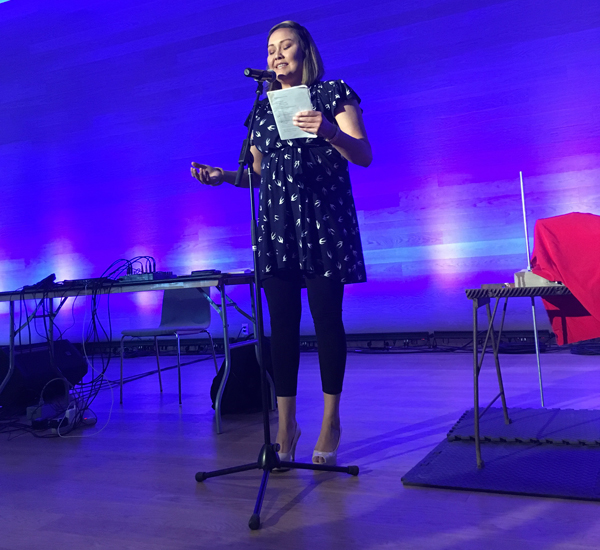
It’s not uncommon to find art made of unconventional materials at the Mann Art Gallery.
But an exhibition coming to the gallery tonight explores art that uses sound as a material. It’s called Northern Landscape Style, and it debuted at the Remai Art Gallery in Saskatoon on June 7.
Northern Landscape Style is a partnership between Holophon Audio Arts of Regina and the Indigenous Peoples Artist Collective (IPAC). It includes works from four Saskatchewan artists who approach sound art in vastly different ways. The show, curated by Michel Boutin of Prince Albert, explores topics such as land, territory, movement and colonization.
In bringing the show together, Boutin said the challenge was choosing which artists fit his vision.
The show kicks off with a performance from sound artist and electronic musician Tod Emel.
“He’s got this piece that explores sounds he recorded in Uranium City, so really far in northern Saskatchewan,” explained Jeff Morton, the managing director of Holophon Audio Arts. “It’s kind of theatre for the ears.”
The piece explores the experience of listening to and creating sounds in a desolate sort of environment.
“I chose Tod because of the work,” Boutin explained.
“He takes ambient sound fro the region and layers it to tell the story of the place.”
The piece serves, Boutin said, as a soundscape to the north.
“I wanted it to be authentic to the north but also authentic to contemporary soundwork,” he said, “authentic to what the north may be rather than the romanticized, traditional idea of it being loons and wind sounds.”
The second performance is by spoken word artist and poet Janelle Pewapsconias.
“She is reading poetry she’s written. There’s a lot to grab onto in what is really personal work,” Morton said.
Boutin has worked with Pewapsconias before. She performed in Prince Albert as part of the Two Story Café, put on annually by IPAC and the Indigenous Poets Society.
“I wanted somebody who was going to tell stories,” Boutin said.
“I wanted something that was from the heart, emotive and story-based.”
That performance is followed by a fiddling performance by Métis fiddler Tristen Durocher, who hails from Buffalo Narrows.
“I’ve worked with Tristen quote a bit in the past. He’s a big draw when it comes to Métis fiddle,” Boutin said.
“He’s a very seasoned musician. He tours a lot,” Morton added. “He’s got a real natural ability onstage to weave in and out of these traditional reels and jigs, mixing fiddling styles from across the country and telling a story about the history of colonization in Canada through this work.”
The show ends with Boutin’s sound performance piece involving contact microphones and a buffalo skull.
“It’s pretty fascinating,” Morton said.
“It’s a really powerful performance, and to have that kind of raw sound. It’s a bit like performance art in a sense, but to get there on this musical journey through different types of music and spoken word really frames the pieces … in connection to these other things.”
Boutin considers himself more of a performance artist than a sound artist. He’s been using sound, though, in his pieces since the 1990s.
“When I was approached by Holophone it jumped out to me to do work with a contact mic and a skull,” Boutin said.
“I thought it would be interesting to actually capture the sound of the skull itself to reference the landscape. It’s an interesting kind of metaphor.”
Morton said the debut performance, held at the Remai as a part of the Strata Festival, appealed to a variety of audiences, including people interested in contemporary and traditional classical music, Remai Modern members and people from the Saskatoon sound art scene. Multiple people came up to Morton after the show to tell him that they enjoyed it.
“We had a mixed audience and I think what really stood out from that performance was the variety of work presented,” he said.
“The real strength and what I heard back from people who were there that night was that there was something they’d never seen in a show like this before where there is such a variety of visual range of approaches to sound making, but still this sort of coherency, this artistic vision at play.”
Morton credits that vision to Boutin, who focused on artists working in Northern Saskatchewan and Northern Canada and making sounds or using sound in art practices that comment on land, territory and movement across Canada.
“The overall idea is that you can bring a very diverse group of artists together who don’t seem related in any way, and find a connection,” Boutin said.
“It’s intended that the audience members experience the artwork individually. Maybe you’re coming to see something specific and you don’t know what sound performance art is, and now you’ll be exposed to it. I’m hoping that in the connection between traditional work and the contemporary work the audience members can see the line between them, and start to see the connection that art has throughout all of the genres.”
In marketing the show, Boutin has been referencing the idea of northern landscape style in western art, which tends to refer to a group of Chinese artists credited with creating what is now known as Chinese International Landscape Style. The diverse group of artists worked in different styles, but their work helped bring unity in a time the country was divided.
“It’s a bit of a call to unity,” Boutin explained.
“Those ideas that through diversity, by finding a common thread, we’ll find our peace.”
Northern Landscape Style begins at 7 p.m. at the Mann Art Gallery. There is no cost to attend.

